Module 6—Work and Energy
 Lesson 2 Lab: The Law of Energy Conservation
Lesson 2 Lab: The Law of Energy Conservation

© WizData, inc./shutterstock
Is mechanical energy conserved when moving down an incline? If so, under what conditions is all of the potential energy converted to kinetic energy, leading to the greatest speed at the bottom?
Prediction
According to the law of conservation of energy, in an isolated system (frictionless), all of the gravitational potential energy of an object at the top of an incline should become kinetic energy when that object reaches the bottom of the incline. In a non-isolated system, when friction is present, energy will be lost; therefore, the total mechanical energy will decrease over time as the amount of potential energy available to be converted to kinetic energy decreases. The applet used in the following simulation helps you explore the motion and forces acting on a mass moving down a smooth, frictionless plane.
Open the Inclined Plane, Frictionless simulation. You can learn more about the simulation and how to use it by reading the Show Me found at the top of the simulation screen.
Procedure and Observations
On the simulation, select the “View Graph” tool (![]() ). Then complete the following steps:
). Then complete the following steps:

- Click on the first set of question marks (“? - ?”). Choose “Time” for the horizontal axis and “Potential Energy” for the vertical axis.

- Click on the next available set of question marks. Choose “Time” for the horizontal axis and “Kinetic Energy” for the vertical axis.

- Click on the next available set of question marks. Choose “Time” for the horizontal axis and “Mechanical Energy” for the vertical axis.
Check to ensure that the coefficient of friction is set to zero.
Press “Play,” and watch the changes in potential and kinetic energy. On the graph, select the “Fit graph” tool to make the graph fully visible. Drag the margins to the right and down to enlarge the window. Click on the down arrow just under the “Zoom In” button to expand the graph further downward.
 Self-Check
Self-Check
SC 1. Sketch the graph for potential energy, kinetic energy, and mechanical energy versus time.
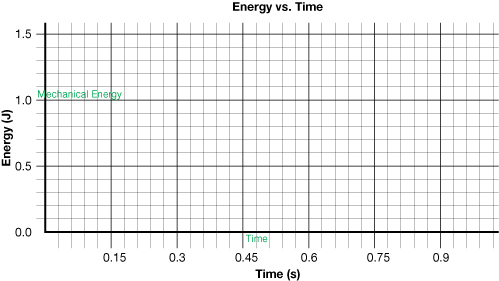
 Self-Check Answers
Self-Check Answers
SC 1.
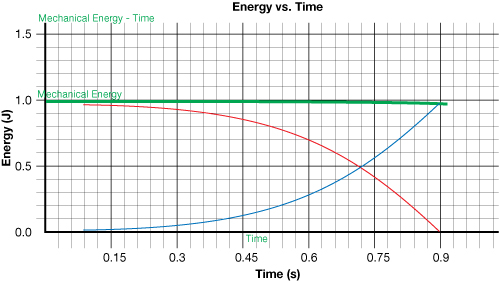
Analysis
 Module 6: Lesson 2 Assignment
Module 6: Lesson 2 Assignment
Remember to submit the answers to LAB 1 and LAB 2 to your teacher as part of your Module 6: Lesson 2 Assignment.
LAB 1.
- What is the total change in potential energy for the block when there is no friction present?
- Where has this energy gone? How can you use this to find the velocity of the block as it reaches the bottom of the incline?
- Calculate the velocity of the block at the bottom of the incline. Use the weight of the block from the data shown at the top of the simulation and the energy from the first graph.
LAB 2. Assume that the block has a potential energy of 0 J when it reaches the bottom of the incline. What can be said about the sum (mechanical energy) of the potential and kinetic energy for the block at any point on the way down the incline when no friction is present?
 Read
Read
Read “Mechanical Energy” on pages 306 to 309 of your textbook.
 Self-Check
Self-Check
SC 2. Complete question 2 of “Practice Problems” on page 309 of your textbook.
 Self-Check Answers
Self-Check Answers
SC 2.
Given
m = 4.50 kg
Em = 6.27 × 104 J
h = 275 m
Required
the speed of the cannon ball (v)
Analysis and Solution
The cannon ball will possess potential energy because of its height and kinetic energy as a result of its speed. Find speed from the kinetic energy using the total mechanical energy formula.
Em = Ek + Ep
Ek = Em – Ep
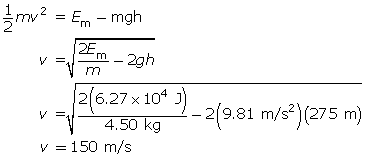
Paraphrase
The speed of the cannon ball is 150 m/s.
 Try This
Try This
TR 1. Solve using energy considerations. Recall from the previous lesson that Ep = ½ kx2. Since F = kx, Ep = ½ Fx.
- A rubber-band slingshot shoots a 25-g stone. What is the initial speed of the stone if the rubber band is drawn back 0.15 m with a force of 27 N?
- How high will the stone rise if it is shot straight upward?
 Read
Read
Read about mechanical energy in isolated systems on pages 311 to 314 of your textbook.
 Self-Check
Self-Check
SC 3. Complete question 1 of “Practice Problems” on page 313 of the textbook.
 Self-Check Answers
Self-Check Answers
SC 3.
Given
Eki = 250 J
ΔEp = 650 J (loss)
Required
the final kinetic energy (Ekf)
Analysis and Solution
The ramp is frictionless, so this is an isolated system. According to the law of conservation of energy, the loss of potential energy will equal the gain in kinetic energy. Therefore, the final kinetic energy will equal the initial kinetic energy less the change in potential energy.
ΔEk = – Δ Ep
Ekf – Eki = – Δ Ep
Ekf = Eki – Δ Ep
Ekf = (250 J) – (–650 J)
Ekf = 900 J
Paraphrase
The final kinetic energy of the crate is 900 J.
 Module 6: Lesson 2 Assignment
Module 6: Lesson 2 Assignment
Remember to submit the answer to TR 2 to your teacher as part of your Module 6: Lesson 2 Assignment.
 Try This
Try This
TR 2. Solve these questions using energy considerations.
a. A 0.80-kg coconut is growing 10 m above the ground in its palm tree. The tree is just at the edge of a cliff that is 15 m tall. What would the maximum speed of the coconut be if it fell to the ground beneath the tree?
b. What would the maximum speed be if it fell from the tree to the bottom of the cliff?
 Read
Read
Read about mechanical energy in pendulums on pages 314 to 316 of the textbook.
 Self-Check
Self-Check
SC 4. Complete question 1 of “Practice Problems” on page 315 of the textbook.
 Self-Check Answers
Self-Check Answers
SC 4.
Given
hf = 15.0 cm
hi = 25.0 cm
m = 250 g
Required
(a) the mechanical energy (Em)
(b) the kinetic energy (Ekf)
(c) the speed (v)
Analysis and Solution
(a) The pendulum is frictionless. So this is an isolated system, and mechanical energy will be conserved. The mechanical energy at any point is equal to the initial potential energy because there was no kinetic energy at the start.
Emi = Epi + Eki
Emi = mghi + ½mvi2
Emi =(0.250 kg)(9.81 m/s2)(0.250 m) + ½(0.250 kg)(0 m/s)2
Emi = 0.613 J
(b) According to the law of conservation of energy, the loss of potential energy will equal the gain in kinetic energy. Therefore, the kinetic energy will equal the initial mechanical energy less the change in potential energy.
Ekf = Emf – ΔEpi
Ekf = Emf –mgΔh
Ekf = (0.613 J) –(0.250 kg)(9.81 m/s2)(0.250 m – 0.15 m)
Ekf = 0.245 J
(c) Use the kinetic energy formula to find the speed.
Ekf = ½mvf2

Paraphrase
(a) The mechanical energy is 0.613 J.
(b) The kinetic energy is 0.245 J.
(c) The speed is 1.40 m/s.
 Module 6: Lesson 2 Assignment
Module 6: Lesson 2 Assignment
Remember to submit the answer to TR 3 to your teacher as part of your Module 6: Lesson 2 Assignment.
 Try This
Try This
TR 3. A pendulum is dropped from the position as shown in the diagram (0.50 m) above the equilibrium position. What is the speed of the pendulum bob as it passes through the equilibrium position?
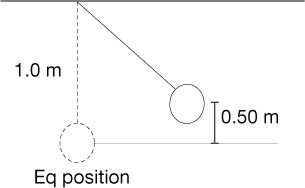
Energy Changes in Non-Isolated Systems
Up to now in this lesson, we have dealt with a frictionless environment. What happens when we consider mechanical energy systems that include friction? Complete the rest of the lab to see.
 Module 6: Lesson 2 Assignment
Module 6: Lesson 2 Assignment
Remember to submit the answer to LAB 3 to your teacher as part of your Module 6: Lesson 2 Assignment.
LAB 3. If necessary, re-open the Inclined Plane, Frictionless simulation.
Set the coefficient of friction to 0.2, and repeat the procedure. You may have to click “Zoom Out” several times to see the whole graph. Sketch the three graphs on the grid below. Label the lines and axes.
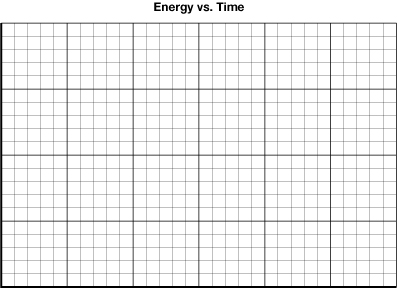
Repeat several trials with greater coefficients of friction each time, up to a maximum of 0.55. Observe how the mechanical energy changes in each case.
 Self-Check
Self-Check
SC 5. Describe the relationship between the coefficient of friction and the total mechanical energy as the object slides down the incline.
 Self-Check Answers
Self-Check Answers
SC 5. As the coefficient of friction increases, the total mechanical energy as the object slides down the incline decreases.
 Module 6: Lesson 2 Assignment
Module 6: Lesson 2 Assignment
Remember to submit the answers to LAB 4 and LAB 5 to your teacher as part of your Module 6: Lesson 2 Assignment.
LAB 4.
- What is the total change in potential energy for the block when there is friction present and the coefficient of friction is 0.20?
- Has all this energy become kinetic? If not, where did it go?
LAB 5. Assume that the block has a potential energy of 0 J when it reaches the bottom of the incline.
- What can be said about the sum (mechanical energy) of the potential and kinetic energy for the block at any point on the way down the incline when friction is present?
- Is mechanical energy still conserved?
Conclusion
The total mechanical energy (sum of the potential and kinetic energy) is conserved in an isolated environment. Any change in either potential or kinetic energy is associated with an equal but opposite change in the other energy. As an object slides down an incline, potential energy is converted into kinetic energy until all of the energy has been transferred from one form to the other.
Mechanical energy is not conserved when friction is present, making the system non-isolated. In this case, some of the potential energy is converted to heat due to the friction, rather than being converted to kinetic energy. Therefore, the mechanical energy decreases over time. By reducing the friction, the loss in mechanical energy can be minimized, resulting in a greater conversion of potential energy into kinetic energy and a greater speed at the bottom of an incline.
- In a frictionless (isolated) environment, mechanical energy is conserved. Therefore, Ep at the top equals Ek at the bottom.
- In a friction (non-isolated) environment, Ep at the top equals Ek at the bottom plus work done to overcome friction.
conservative force: a force such as gravity, acting in an isolated system, where the total work done is independent of the path an object is moved through
non-conservative force: a force acting on a non-isolated system from outside the system or from friction; a force where the total work done depends on the path an object is moved through
It is important to note that the forces related to potential energy (gravitational and elastic forces) and kinetic energy act within the isolated system and do not affect the mechanical energy of the system. These forces are called conservative forces. Other forces, such as friction and forces from outside a non-isolated system, affect the mechanical energy of the system and are called non-conservative forces. The following Conservative and Non-conservative Forces simulation gives a visual and graphical representation of these forces.
